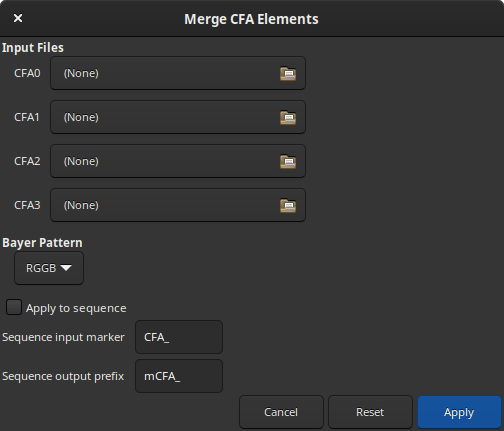Merge CFA Channels

The purpose of this tool is to combine multiple monochrome images that have been previously extracted from a CFA sensor (with the menu for example). The tool merges the separate red, green (x2), and blue channel images into a single composite image called CFA image.
Warning
This tool is dedicated to images from a Bayer matrix and therefore it cannot work with images from X-Trans files from Fuji cameras.
The dialog is split in three different parts:
Input files: Select the image containing the CFA0, CFA1, CFA2 and CFA3 Bayer subpatterns. If this has been produced using Siril's Split CFA function it will have the CFA prefix.
Bayer Pattern: Sets the Bayer pattern header to be applied to the result. This must match the Bayer pattern of the image that the original Bayer subchannels were split from.
The sequence part, at the bottom, allows to process whole sequences by reconstituting a CFA image sequence. Clicking on the Apply to sequence button displays a help text to proceed correctly. This text is reported in the next tooltip. There are two available options:
Sequence input marker: Identifier prefix used to denote CFA number in the separate CFA channel images. This should be set to whatever sequence prefix was used when the split_cfa process was run (default:
CFA_).Sequence output prefix: Prefix of the image names resulting from the merge CFA process. By default it is
mCFA_.
Tip
You must have the CFA0 sequence selected in the main window sequence tab.
Your separate sub-CFA sequences must have been processed in exactly the same way.
The filenames must be in the same directory and must differ only by the name of the CFA channel. i.e. if a CFA0 image is r_pp_CFA_0_Light_0001.fit, the corresponding images for the other CFA channels must be r_pp_CFA_1_Light_0001.fit, r_pp_CFA_2_Light_0001.fit and r_pp_CFA_3_Light_0001.fit.
Each image in the sequence will only be processed if the corresponding images for the other 3 CFA channels can be found. Both G1 and G2 are required. Note this means that if you discard an image containing one CFA channel of an image between split_cfa and merge_cfa, merge_cfa will be unable to merge the remaining CFA channels for that image. All sequence filtering should be done either before split_cfa or after merge_cfa.
Siril command line
merge_cfa file_CFA0 file_CFA1 file_CFA2 file_CFA3 bayerpattern
Siril command line
seqmerge_cfa sequencename bayerpattern [-prefixin=] [-prefixout=]